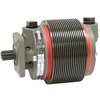Flew a long xc from MN to MO and back two weeks ago, put 8.6 hours on and flew perfectly both ways. Haven't flown since until today. Started up, and immediately ran rough. Sounded "louder", with vibration that increased with RPMs until the dash was visibly shaking. Brought it back down to 1000 rpm and tach would slowly drop, engine would sputter, catch itself/recover, and repeat. Leaning didn't help. Primer was in and locked. Cycled mags, all normal. Gauges in the green. Shut down and let it sit, tried a few more times, same result. Went home.
It has not flown since it came back from the long xc two weeks ago, and it ran great. What happened in that down time?
Current thoughts are: stuck valve, carb float, fouled plugs (100LL) or vacuum leak. Your thoughts are appreciated.
It has not flown since it came back from the long xc two weeks ago, and it ran great. What happened in that down time?
Current thoughts are: stuck valve, carb float, fouled plugs (100LL) or vacuum leak. Your thoughts are appreciated.


